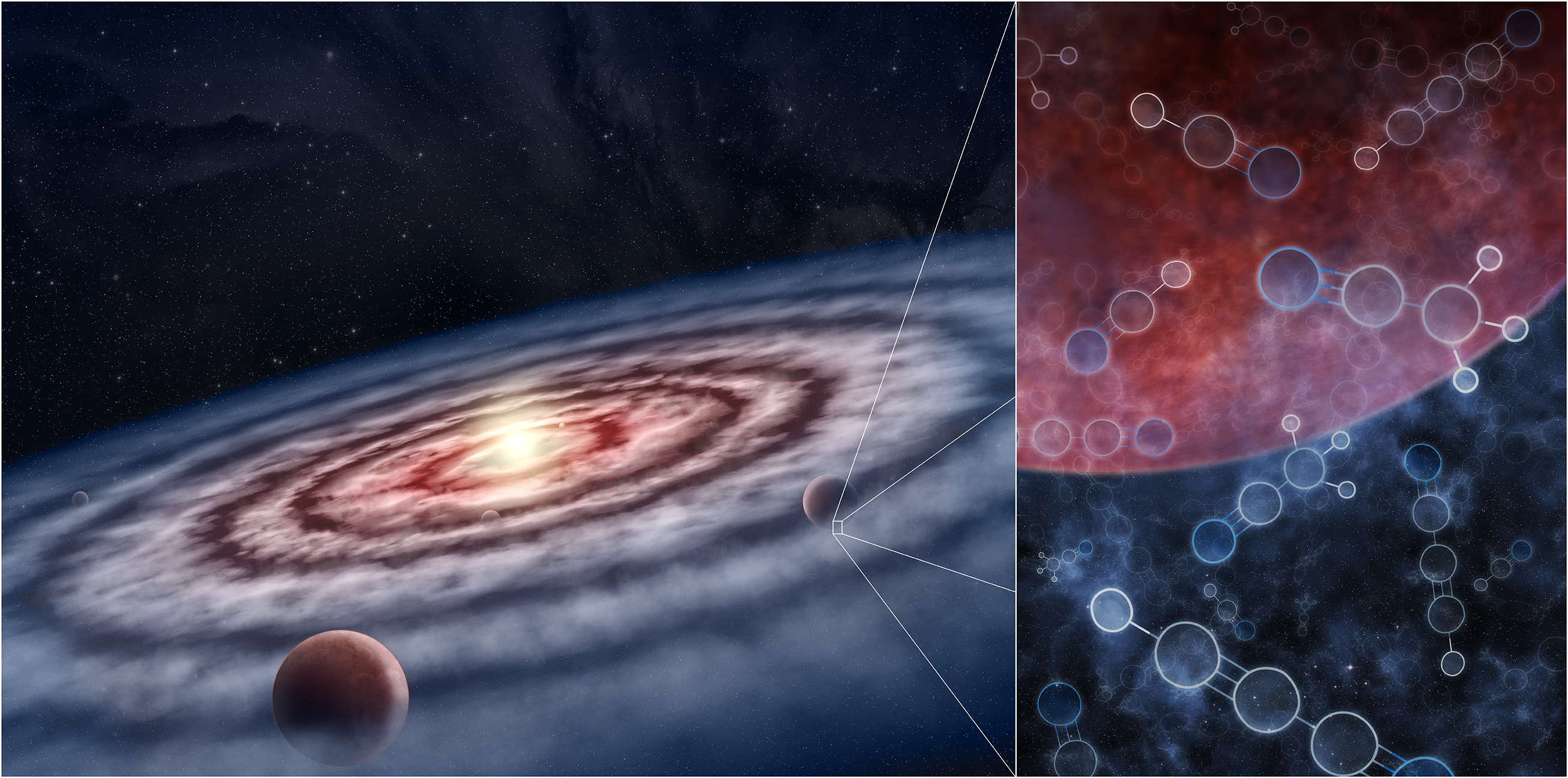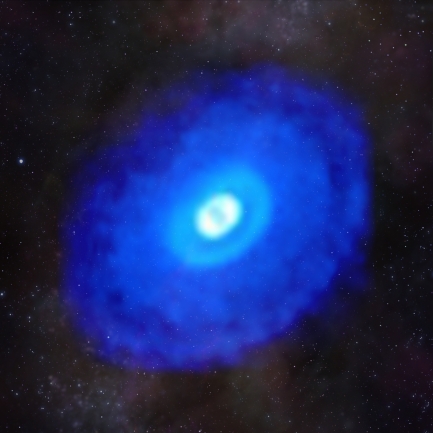This composite image of ALMA data from the young star HD 163296 shows hydrogen cyanide emission laid over a starfield.
Planets Form in Organic Soups With Different Ingredients

In this artist’s conception, planets form from the gas and dust in the protoplanetary disk surrounding a young star. The gas is made up of many different molecules, including hydrogen cyanide and more complex nitriles—linked to the development of life on Earth. The soup of molecules in a particular location in the disk shapes the future of the planet forming there and determines whether or not that planet could support life as people know it. Credit: M.Weiss/Center for Astrophysics | Harvard & Smithsonian
Astronomers have mapped out the chemicals inside of planetary nurseries in extraordinary detail. The newly unveiled maps reveal the locations of dozens of molecules within five protoplanetary disks—regions of dust and gas where planets form around young stars.
“These planet-forming disks are teeming with organic molecules, some which are implicated in the origins of life here on Earth,” said Karin , an astronomer at the Center for Astrophysics | Harvard & Smithsonian (CfA) who led the map-making project and is lead author of MAPS I, the first paper in the series. “This is really exciting; the chemicals in each disk will ultimately affect the type of planets that form—and determine whether or not the planets can host life.”
A series of 20 papers detailing the project, appropriately named Molecules with ALMA at Planet-forming Scales, or MAPS, was published today in the open-access repository arXiv. The papers have also been accepted to the Astrophysical Journal Supplement as a forthcoming special edition series to showcase the high-resolution images and their implications.
Planets Form in Different Soups
The new maps of the disks reveal that the chemicals in protoplanetary disks are not located uniformly throughout each disk; instead, each disk is a different planet-forming soup, a mixed bag of molecules, or planetary ingredients. The results suggest that planet formation occurs in diverse chemical environments and that as they form, each planet may be exposed to vastly different molecules depending on its location in a disk.
“Our maps reveal it matters a great deal where in a disk a planet forms,” Öberg said. “Many of the chemicals in the disks are organic, and the distribution of these organics varies dramatically within a particular disk. Two planets can form around the same star and have very different organic inventories, and therefore predispositions to life.”
CfA graduate student Charles Law led MAPS III, the study that mapped out the specific locations of 18 molecules, including hydrogen cyanide, and other nitriles connected to the origins of life, in each of the five disks. The images were taken with the Atacama Large Millimeter/submillimeter Array (ALMA) in 2018 and 2019. The vast amount of data collected required a 100-terabyte hard drive and took two years to analyze and breakdown into separate maps of each molecule.
The final maps of each disk surprised Law and showed that “understanding the chemistry occurring even in a single disk is much more complicated than we thought.”
“Each individual disk appears quite different from the next one, with its own distinctive set of chemical substructures,” Law said. “The planets forming in these disks are going to experience very different chemical environments.”
Fishing for Planetary Newborns
The MAPS project provided astronomers with opportunities to study more than just the chemical environment of disks.
“Our team used these maps to show where some of the forming planets are located within disks, enabling scientists to connect the observed chemical soups with the future compositions of specific planets,” Öberg said.
The effort was led by Richard Teague, a Submillimeter Array fellow at the CfA, who used the data and imagery collected by MAPS to hunt for newborn planets.
Astronomers are confident that planets form in protoplanetary disks, but there is a catch: they cannot directly see them. Dense gas and dust, which will last some three million years, shields young, developing planets from view.
“It’s like trying to see a fish underwater,” Teague said. “We know they’re there, but we can’t peer that far down. We have to look for subtle signs on the surface of the water, like ripples and waves.”
In protoplanetary disks, gas and dust naturally rotate around a central star. The speed of the moving material, which astronomers can measure, should remain consistent throughout the disk. But if a planet is lurking beneath the surface, Teague believes it can slightly disturb the gas traveling around it, causing a small deviation in velocity or the spiraling gas to move in an unexpected way.
Using this tactic, Teague analyzed gas velocities in two of the five protoplanetary disks—around the young stars HD 163296 and MWC 480. Small hiccups in velocity in certain portions of the disks revealed a young Jupiter-like planet embedded in each of the disks. The observations are detailed in MAPS XVIII.
As the planets grow, they will eventually “carve open gaps in the structure of the disks” so we can see them, Teague said, but the process will take thousands of years.
Teague hopes to confirm the discoveries sooner than that using the forthcoming James Webb Space Telescope. “It should have the sensitivity to pinpoint the planets,” he said.
Law also hopes to confirm the results by studying more protoplanetary disks in the future.
Law said, “If we want to see if the chemical diversity observed in MAPS is typical, we’re going to need to increase our sample size and map out more disks in the same way.”
About ALMA
The Atacama Large Millimeter/submillimeter Array (ALMA), an international astronomy facility, is a partnership of the European Organisation for Astronomical Research in the Southern Hemisphere (ESO), the U.S. National Science Foundation (NSF) and the National Institutes of Natural Sciences (NINS) of Japan in cooperation with the Republic of Chile. ALMA is funded by ESO on behalf of its Member States, by NSF in cooperation with the National Research Council of Canada (NRC) and the Ministry of Science and Technology (MOST) and by NINS in cooperation with the Academia Sinica (AS) in Taiwan and the Korea Astronomy and Space Science Institute (KASI).
ALMA construction and operations are led by ESO on behalf of its Member States; by the National Radio Astronomy Observatory (NRAO), managed by Associated Universities, Inc. (AUI), on behalf of North America; and by the National Astronomical Observatory of Japan (NAOJ) on behalf of East Asia. The Joint ALMA Observatory (JAO) provides the unified leadership and management of the construction, commissioning and operation of ALMA.
About the Center for Astrophysics | Harvard & Smithsonian
The Center for Astrophysics | Harvard & Smithsonian is a collaboration between Harvard and the Smithsonian designed to ask—and ultimately answer—humanity’s greatest unresolved questions about the nature of the universe. The Center for Astrophysics is headquartered in Cambridge, MA, with research facilities across the U.S. and around the world.
# # #
SI-286-2021

